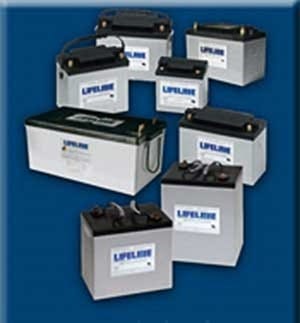
Question: Due to space considerations I want to use two 105 amp hour and two 150 amp hour batteries as a house battery bank. Would this arrangement be detrimental to the smaller batteries?
Answer: My gut reaction is that mixing two sizes of batteries would be a bad idea. Having said that, I really can’t think of a technical reason that it would not work. Let’s see what our battery guru, Justin at LifeLine Battery says:
“It has previously been said that this is not a good idea; however, we have done some pretty extensive lab testing and we can find no differences in the batteries. Age is important but size is not. You can safely mix and match battery sizes in one bank.
Also, Sabre Yachts does this from the factory. This was one of the reasons we started testing this scenario. Sabre use a GPL-4DL and when they want to upgrade a battery bank they add a GPL-31T.”
So far Justin is batting 100% on everything he has told us about batteries, so I’m betting he is right about this too.
What I find interesting is that this is yet another incidence when what is taken for common wisdom about batteries and their use on sailboats turns out to be wrong. I’m guessing that there is more misinformation about batteries out there than just about any other piece of gear. I know that prior to working with Justin and writing the series of posts on batteries (see below) I, for one, was seriously ignorant on the subject despite thinking that I understood it. And I’m an electronics technician by trade who should, at least in theory, have a leg up on the run-of-the-mill boat owner.

Age is important but size is not. You can safely mix and match battery sizes in one bank.
———
Where do you find the age of a battery? Is it marked with a production date?
Do all brand/types have this?
Hi Geir Ove,
Unfortunately, as far as I know, there is no standard way to tell the age of a battery. Most I have seen have stickers with years and months printed on them and removable round holes pre-punched so that the installer can indicate the date they were put in service. Of course that only helps if the installer does it.
On the other hand, I think what matters here more than the manufacturing date is the in service date since that is when the inevitable decrease in capacity from use, no matter how well treated, will start.
I would agree with Justin’s assessment, in the case where the batteries are all installed at the same time and share similar chemistry. Given identical chemistry in all modules (e.g. all are flooded lead – sulphuric acid), the voltage profiles will match and they should balance the charge/discharge currents appropriately among themselves. I’m glad Lifeline’s tests appear to confirm what should theoretically be true; it does open up some more design options.
Where you encounter problems is when someone says “I have two 4Ds already, can I add a Gp31 in parallel?” Or, “I have three Gp31 gels, can I add a Gp31 AGM?” Or, “I’ve had these two 8Ds for a few years, can I add a third?” In all these cases, the voltage profiles will not match, and one cell will shoulder a disproportionate share of the charge/discharge current, possibly burning the whole works out much faster.
Hi Matt,
Thanks for the confirmation.
[For those that don’t know, Matt is an engineer who has substantial experience with batteries including some of the new technology ones that blow up if you look at them sideways!]
As far as I know, all batteries have a manufacturing date embossed in their plastic cases. Date codes from most manufacturers work like this: The code is a string of letters numbers, but all the real information you need is in the first two characters. Usually, the code starts with a letter that corresponds with the month—‘A’ for January through ‘L’ for December (some manufacturer’s codes omit ‘I’; for them, ‘M’ indicates December). The second character of the code is a numeral that stands for the year. Thus, a code starting ‘A2’ indicates that the battery was shipped in January 2002; ‘B2’ indicates February 2002, and so on. (Delco reverses the letter and the number; a Delco code starting with ‘2C’ indicates the battery was shipped in March 2002.)
Hi Scott,
That’s great information, thank you!
The question is how big a difference can the sizes be? The smaller Ah capacity battery must eventually get down to a capacity where its voltage falls off more quickly than the larger batteries – dragging them down.
So – taking things to their extreme, a 1Ah battery and a 100 Ah battery would surly not work well together.
Hi Matt,
Within reason, the ratio between the larger and smaller battery, as long as they are of the same age and type, should make no difference. Each will output the amount of current (amps) that it can at a given voltage. As the smaller discharges the larger will shoulder more of the load and vice versa.
Let me express my doubts another way.
A common situation might be a 200 Ah battery and a 100Ah. Discharge this bank to 50% and what actually happens if you disconnect both batteries and test their capacity? The bank will have lost 150Ah, so will the 200Ah battery be down to 100Ah and the 100Ah bat be down to 50Ah – or will they be down by 75Ah each, which would mean the 100Ah battery is below the 50% threshold and the 200Ah is above 50% discharged?
Hi Matt,
To answer your question, in the situation you postulate, the 200 Ah battery would discharge to 100Ah and the 100Ah to 50Ah, assuming that both batteries were the same age and health. Therefore each battery would be at 50% charge at the end of the test and all would be fine. The reason is that battery voltage is a function of percentage discharge regardless of overall capacity. Therefore, as each battery discharges, its voltage drops in unison with the other and each battery will continue to supply current (amps) in proportion to size as it relates to the overall bank size.
Thanks for that John.
This really is a dramatic change in thinking, so many people who would like a bigger service bank should be able to find extra space to add one or two smaller batteries. Great info on this whole Lifeline thread.
Just for the record we have 5 x 210 Ah Lifelines – 6 years old and I equalized them earlier this year as they seemed to be lacking in capacity. To charge then we have a Fischer Panda 4 Kva DC generator which charges at 280 amps. I’ve not met anyone else doing this – but its fasts and works for us. AC is available all the time via a 2.5 KVA Victron inverter. We even run our 12,000 BTU air-con from the batteries.
Lifeline say that when the batteries get old the open circuit voltage at 50% discharged may be less than 12.2v. It would be nice to know how much lower, as maybe mine weren’t low in capacity when I equalized them.
To measure the open circuit voltage I just disconnect the negative of one for 4 hours – choosing a different one each time.
Hi Matt,
Glad to help. Your system sounds great. I did not even know that Fisher Panda made a DC gen set! Makes way more sense that making AC and then converting it to DC, as we do. Mind you, our Northern Lights AC generator will probably outlast me (20 years and counting) so I guess I won’t get to try DC.
As to measuring open circuit voltage as a way to access battery health, I think a discharge test is actually a better solution.